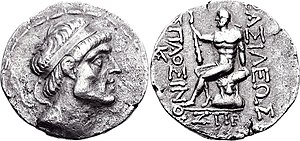|
Hispaosines (juga disebut Aspasine) adalah seorang pangeran Iran, dan pendiri Karakene, sebuah kerajaan yang terletak di selatan Mesopotamia. Ia awalnya adalah seorang satrap Seleukia yang diangkat oleh raja Antiokhus IV Epifanes (m. 175 – 164 SM), tetapi mendeklarasikan kemerdekaan pada 141 SM setelah kejatuhan otoritas Seleukia di Iran dan Babel ke tangan Partia. Hispaosines sempat menduduki kota Partia Babel pada 127 SM, dimana ia diangkat menjadi raja (šarru). Namun, pada 124 SM, ia terpaksa mengakui kedaulatan Partia. Ia meninggal pada tahun yang sama, dan digantikan oleh putranya yang masih remaja Apodakos.
Referensi
Daftar pustaka
Karya kuno
- Pliny the Elder Natural History, VI 139
- Lucian, Macrobii.
- Astronomical Diaries (now in the British Museum and in a private collection. Following cuneiform texts refer to Hyspaosinesː British Museum nos 33461, 3386, 55070, 45699, 34274, 45708, 45693, 45853, 33024). They are published in Abraham Sachs, Hermann Hunger: Astronomical Diaries and Related Texts from Babylon, III, Diaries from 164 BC. to 61 B.C. Verlag der Österreichischen Akademie der Wissenschaften, Vienna 1996, ISBN 3-7001-2578-X, pp. 216–282. The tablet in the private collection is published by T. G. Pinchesː Babylonian and Oriental Record, Vol. IV, London 1890, 131-141 online.
Karya modern
- Bivar, A.D.H. (1983). "The Political History of Iran Under the Arsacids". Dalam Yarshater, Ehsan. The Cambridge History of Iran, Volume 3(1): The Seleucid, Parthian and Sasanian Periods. Cambridge: Cambridge University Press. hlm. 21–99. ISBN 0-521-20092-X.
- Brosius, Maria (2006), The Persians: An Introduction, London & New York: Routledge, ISBN 978-0-415-32089-4
- Curtis, Vesta Sarkhosh (2007), "The Iranian Revival in the Parthian Period", dalam Curtis, Vesta Sarkhosh and Sarah Stewart, The Age of the Parthians: The Ideas of Iran, 2, London & New York: I.B. Tauris & Co Ltd., in association with the London Middle East Institute at SOAS and the British Museum, hlm. 7–25, ISBN 978-1-84511-406-0
- Dąbrowa, Edward (2012). "The Arsacid Empire". Dalam Daryaee, Touraj. The Oxford Handbook of Iranian History. Oxford University Press. ISBN 978-0-19-987575-7.
- Erskine, Andrew; Llewellyn-Jones, Lloyd; Wallace, Shane (2017). The Hellenistic Court: Monarchic Power and Elite Society from Alexander to Cleopatra. The Classical Press of Wales. ISBN 978-1910589625.
- Eilers, Wilhelm (1983). "Iran and Mesopotamia". Dalam Yarshater, Ehsan. The Cambridge History of Iran, Volume 3(1): The Seleucid, Parthian and Sasanian Periods. Cambridge: Cambridge University Press. hlm. 481–505. ISBN 0-521-20092-X.
- Garthwaite, Gene Ralph (2005), The Persians, Oxford & Carlton: Blackwell Publishing, Ltd., ISBN 978-1-55786-860-2 .
- Galier, P.L.; P. Lombard, K.M. al-Sindi (2002): Greek Inscriptions from Bahrain, In: Arabian archaeology and epigraphy, 13, pp. 223–26 the Inscription from Bahrain (pdf)
- Hansman, John (1991). "Characene and Charax". Dalam Yarshater, Ehsan. Encyclopædia Iranica, Volume V/4: C̆es̆tīya–Chinese-Iranian relations VIII. London and New York: Routledge & Kegan Paul. hlm. 363–365. ISBN 978-0-939214-71-6.
- Schuol, Monika (2000), Die Charakene: ein mesopotamisches Königreich in hellenistisch-parthischer Zeit, Stuttgart: . Steiner, ISBN 3-515-07709-X .
- Shayegan, M. Rahim (2011). Arsacids and Sasanians: Political Ideology in Post-Hellenistic and Late Antique Persia. Cambridge University Press. ISBN 9780521766418.
Bacaan tambahan
|
